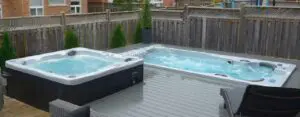November 12, 2025
Category: Swim Spa
For most structured training at home, a swim spa makes steady pacing and intervals simpler than a home swimming pool.
You want a setup that helps you train well, not one that gathers dust. We’ll focus on fitness effectiveness: pace control, interval structure, technique feedback, and how often you’ll swim. Here, a “home swimming pool” is a private pool at home, and a “swim spa” is a compact swim‑in‑place unit with a controllable current.
Can you hold a steadier pace in a swim spa than a home swimming pool?
For endurance work, repeatability matters. In a swim spa, you set a current and hold it, so your pace stays steady for the full set. No wall turns or push-off surges that fade after a few strokes. In a home swimming pool, your pace depends on pool length, turn sharpness, and how consistently you push off. You can still pace well in a pool, but it takes more attention and more space. If you want to build aerobic capacity in short windows, the swim‑in‑place current gives you a straightforward way to lock a pace and focus on rhythm. For those seeking a stronger flow and endurance precision, the Hydropool Executive Trainer 19EX or its compact counterpart, the Hydropool Executive Trainer 16EX, are designed to deliver a controlled, stable current for focused training.
Which is better for intervals and structured workouts?
Intervals get easier when you can change pace on cue and see a clear rest window. Models like the Hydropool AquaTrainer 17AX give swimmers clear pace shifts and integrated seating for recovery between sets. In a swim spa you tap up or down to shift from easy to hard. Your rest interval starts the moment you stop the stroke rather than when you reach the wall. That clarity makes classic sets simple, like 10×1‑minute hard with 1‑minute easy, or 5×4‑minute steady with 1‑minute easy. In a home swimming pool, you can do the same sessions, but rests and splits depend on where you hit the wall and how long each length runs. The swim spa keeps the work-to-rest pattern precise, so you spend more time swimming the set and less time fiddling with splits.
What about technique and line‑hold?
Good form turns effort into speed. In a swim spa you swim in place against a constant flow, so flaws show up quickly. Watch hand entry. Keep bubbles behind the hand, not across it. Keep your head quiet and look slightly down so you don’t “climb” the flow. You’ll feel body position drift if your hips sink or the kick loses rhythm, and you can correct it as you go. A home swimming pool works well for drill lengths and stroke variety. It’s also good for turn practice, but the steady flow in a swim spa gives immediate feedback on posture and timing. If you use a waterproof mirror or camera, you can double‑check what you feel.
Will you train more often with a swim spa than with a home swimming pool?
Frequency beats perfection. A swim spa usually sits closer to the house and warms up on schedule, so you can knock out a 15–20‑minute set before work or after the school run. Open the cover, set the flow, and go. A home swimming pool offers more open water, but in many UK gardens it ends up more seasonal unless you heat it heavily. If your goal is “more sessions this month,” the warm, ready water near the back door removes friction and makes short, regular swims realistic. Those short sessions add up fast.
Strength and cross‑training: who wins?
Both options can support strength and mobility. In a swim spa, you can add tethered work, paddles, or resistance accessories. Some models take add‑ons such as rowing kits or underwater treadmills. The controlled flow also makes steady kick sets practical without chasing a wall. A home swimming pool gives space for longer kick lengths, partner drills, and mixed family sessions. If your fitness plan leans toward structured solo work, the swim spa’s controllable current helps. If you want long, social sets with plenty of turning practice, the home swimming pool fits that brief.
Space, upkeep and seasonality: what matters for fitness?
Space: A swim spa’s smaller footprint often means siting close to the house. Compact models such as the Hydropool AquaTrainer 14AX make daily training realistic even in smaller gardens. In bad weather, a shorter walk makes you more likely to swim. A home swimming pool needs more space and usually sits farther from the back door.
Upkeep: A swim spa holds less water than a full home swimming pool, so routine care often takes less time. Faster water care means fewer hurdles between you and today’s session.
Seasonality: A heated swim spa is commonly used year‑round in the UK. A home swimming pool can run year‑round too, but it usually needs more heating and more weather planning. For many households, that difference changes how often they swim through winter.
Is a swim spa good for winter training in the UK?
Yes. A well‑insulated swim spa with a fitted cover and sensible schedules can support regular winter sessions. Keep the cover closed between swims and heat for your typical windows. This setup makes cold‑weather training practical for many households.
What does a practical fitness week look like?
You don’t need a complex plan. Use a routine you’ll follow and adjust.
- Endurance x2 (20–25 minutes): Hold a steady flow you can maintain with clean form.
- Intervals x1 (15–20 minutes): Short bursts with easy recoveries. Keep the work segments honest.
- Mobility or technique x1 (10–15 minutes): Easy flow. Focus on relaxed shoulders and tidy hand entry.
- Family or fun block x1: Light play, easy kick, or technique games. It keeps motivation high.
Because it sits nearby, these sessions don’t swallow an evening. Set a 15‑minute timer so swims stay focused and finish on time.
So which is better for fitness at home?
It comes down to how you like to train. If you value steady pacing, clear intervals, and rapid feedback on form, the swim‑in‑place current in a swim spa makes structured work straightforward. If you prefer open‑water feel, long lengths, and group sets, a home swimming pool serves you well. Many swimmers train in a swim spa midweek and keep long, social swims for larger pools.
Find your pace in person: book a wet test at our showroom
Book a wet test and compare easy, steady and hard paces. Notice how well you hold a line and how quickly you can settle into rhythm. Then check your space and access, and decide where to put steps, lighting and service access. If you want fitness and recovery in one unit, the Hydropool AquaTrainer 19DTAX offers dual‑zone temperature control for training and relaxation. A quick site survey confirms the practical details. When the setup fits your routine, you’re more likely to use it, and you can see the fitness gains you’re working for.
Visit our showroom or speak with our team to find the right swim spa for your training goals. Contact us to arrange your visit or request more details.


